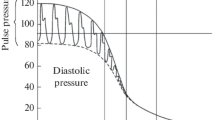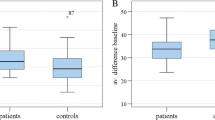Summary
Conjunctival oxygen tension and arterial blood gases were measured in 20 patients with acute ischaemic stroke and compared to values obtained in a reference group. The conjunctival capillary bed is perfused by the ophthalmic artery and, thus, reflects the oxygen delivery to the areas supplied by the internal carotid artery. Patients with acute ischaemic stroke showed especially on the ipsilateral side, i.e. the side of the infarction, and to a lesser extent on the other side a lowered conjunctival oxygen tension and a reduced ratio of conjunctival to arterial oxygen tension. These findings indicate disturbances of the blood fluidity, of the cerebrovascular autoregulation and of brain microperfusion. Monitoring of conjunctival oxygen tension is simple and safe. This method allows the assessment of oxygen tension in a tissue bed vascularized by the internal carotid artery. It appears to yield an objective criterion of the effectiveness of therapeutic procedures aiming at an improvement of cerebral perfusion and oxygen supply in patients with acute ischaemic stroke.
Similar content being viewed by others
Abbreviations
- pO2 :
-
Sauerstoffpartialdruck
- pCO2 :
-
Kohlendioxydpartialdruck
- konj:
-
konjunktival
- A.:
-
Arterie
- art:
-
arteriell
- re:
-
rechts
- li:
-
links
- m:
-
mittleren
- i:
-
ipsilateral
- k:
-
kontralateral
Literatur
Abraham E, Oye RK, Smith M (1984) Detection of blood volume deficits through conjunctival oxygen tension monitoring. Crit Care Med 12:931–934
Abraham E, Smith M, Silver L (1984) Conjunctival and transcutaneous oxygen monitoring during cardiac arrest and cardiopulmonary resuscitation. Crit Care Med 12:419–421
Ehrly AM, Köhler HJ, schroeder W, Müller R (1975) Sauerstoffdruckwerte im ischämischen Muskelgewebe von Patienten mit chronischen peripheren arteriellen Verschlußkrankheiten. Klin Wochenschr 53:687–688
Ewing JR, Keating EG, Sheehe PR, Hodge CJ, Chipman M, Brooks CT (1981) Concordance of Inhalation rCBFs with Evidence of Cerebral Ischemia. Stroke 12:188–191
Fatt I, Deutsch TA (1983) The relation of conjunctival pO2 to capillary bed pO2. Crit Care Med 11:445–448
Fink S, Ray CW, McCartney S, Ehrlich H, Shoemaker WC (1984) Oxygen transport and utilization in hyperoxia and hypoxia: Relation of conjunctival and transcutaneous oxygen tensions to hemodynamic and oxygen transport variables. Crit Care Med 12:943–948
Gaehtgens P (1982) Hämodynamik der Mikrozirkulation. Therapiewoche 32:5035–5042
Hartmann A (1985) Prolonged Disturbances of Regional Cerebral Blood Flow in Transient Ischemic Attacks. Stroke 16:932–939
Hauck G (1984) Physiologische Aspekte der Hämorheologie. Hämostaseologie 4:9–12
Herrschaft H (1978) Pathophysiologische Grundlagen zerebraler Durchblutungs-und Stoffwechselstörungen. Dtsch Ärztebl 75:3095–3105
Isenberg JS, Shoemaker WC (1983) The transconjunctival oxygen monitor. American J of Ophthalmology 95:803–806
Kram HB (1985) Noninvasive Tissue Oxygen Monitoring in ICU: Past, Present, and Future. Intensive Crit Care Digest 4:27–29
Nisam M, Albertson TE, Panaces E, Rutherford W, Fisher CJ (1986) Effects of hyperventilation on conjunctival oxygen tension in humans. Crit Care Med 14:12–15
Olsen TS, Larsen B, Herning M, Skriver EB, Lassen NA (1983) Blood Flow and Vascular Reaktivity in Colaterally Perfused Brain Tissue. Evidence of an Ischemic Penumbra in Patients with acute Stroke. Stroke 14:332–341
Podolsky SM, Waninger K, Wertheimer J (1985) Conjunctival Oxygen Monitoring in Atrial Flutter. Am J Emergency Med 3:541–542
Powers WJ, Raichle ME (1985) Positron Emission Tomography and its Application to the Study of Cerebrovascular Disease in Man. Stroke 16:361–376
Sachs L (1984) Angewandte Statistik. Springer Verlag, Berlin
Scheffler P, Jung F, Mrowietz C, Waldhausen P, Leipnitz G, Häuser B (1987) Hämorheologische, mikro- und makrozirkulatorische Effekte einer hypervolämischen Infusion mittelmolekularer Hydroxyäthylstärke (10%, 200 000/0,62) bei Gesunden. Infusionstherapie 14:233–238
Schmid-Schönbein H (1982) Physiologie und Pathopysiologie der Mikrozirkulation aus rheologischer Sicht. Internist 23:359–374
Shoemaker WC, Fink S, Ray CW, McCartney S (1984) Effect of hemorrhagic shock on conjunctival and transcutaneous oxygen tensions in relation to hemodynamic and oxygen transport changes. Crit Care Med 12:949–952
Shoemaker WC, Lawner PM (1983) Method for continuous conjunctival oxygen monitoring during carotid artery surgery. Crit Care Med 11:946–947
Simon J, Jung F, Holbach T, Mrowietz C, Jaksche H, Kiesewetter H (1986) Einfluß verschiedener Volumenersatzmittel auf die Fließfähigkeit des Blutes und den konjunktivalen Sauerstoffpartialdruck. Krankenhausarzt 59:814–821
Staedt U, Hütt M, Leweling H, Heene DL (1988) Konjunktivaler Sauerstoffdruck bei Patienten mit akutem zerebrovaskulären Insult vor und nach Hämodilution. Klin Wochenschr 66, Suppl XIII:268
Weisskopf V, Mueller C, Weidler B, Balzer K, Fanoulas G, Fidorra K (1987) Erfahrungen mit der conjunktivalen pO2-Druckmessung (PcjO2) im Rahmen rekonstruktiver Operationen an den extracraniellen Hirngefäßen. Angio 9:237–246
Author information
Authors and Affiliations
Rights and permissions
About this article
Cite this article
Staedt, U., Holm, E., Kortsik, C.S. et al. Konjunktivaler Sauerstoffdruck von Patienten mit akutem Hirninfarkt. Klin Wochenschr 66, 628–632 (1988). https://doi.org/10.1007/BF01728804
Received:
Revised:
Accepted:
Issue Date:
DOI: https://doi.org/10.1007/BF01728804




